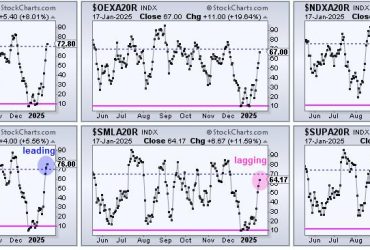Uncertainty in the stock market makes it difficult to make investment decisions. When investors sell off stocks, everyone follows without giving it much thought and you’re left trying to figure out which path you should take. We saw this price action in the stock market on Wednesday after the Federal Open Market Committee cut interest rates by a quarter percentage point. Investors started to sell their holdings, which intensified toward the last few minutes of the trading day.
The rate cut didn’t come as a surprise. The market had already priced it in. Fed Chairman Jerome Powell’s comments about slowing down rate cuts for the next two years led to the massive selloff. Inflationary concerns were one reason which may have heightened investor fear. The S&P 500 ($SPX) fell by 2.95%, and the Nasdaq Composite ($COMPQ) dropped by 3.56%. The S&P 600 Small Cap Index ($SML) got hit hard, falling over 4%.
It wasn’t just equities that sold off. Gold prices fell. Silver prices fell. Bond prices fell. Even cryptocurrencies felt the pain.
So, how damaging was the selloff? Let’s dive into the charts of the broader stock market indexes.
Equities Hammered Hard
Whenever there’s such a significant fall in equities, it’s natural to think about buying the dip. But before you jump into anything, it’s best to see if the uptrend is still in play.
From its August low, the S&P 500 has been in an upward trend with a few pullbacks, the deepest one being in early September when it almost reached its 100-day simple moving average or SMA (see chart below). On Wednesday, the index closed below its 50-day SMA toward the low of the day. The daily chart below shows market breadth is declining.
FIGURE 1. DAILY CHART OF THE S&P 500 INDEX WITH BREADTH INDICATORS. The index is close to hitting its late November lows, a key support level. If it breaks below that level and market breadth indicators continue to weaken, it could be a bearish signal. Chart source: StockCharts.com. For educational purposes.
The NYSE Advance-Decline Line (!ADLINENYC), the percent of S&P 500 stocks trading above their 200-day moving average ($SPXA200R), and the S&P 500 Bullish Percent Index ($BPSPX) are all trending lower. That the $BPSPX is below 50 shows that bearish pressure is dominant, which is concerning.
The weekly chart is more optimistic in that the S&P 500 is still trending higher and above its 21-week exponential moving average (EMA). All the moving averages on the chart are trending higher. Watch the November lows carefully (blue dashed line). A close below this level would mean a break in the “higher highs, higher lows” trend.
FIGURE 2. WEEKLY CHART OF S&P 500 INDEX. All moving averages overlaid on the chart are trending higher. The S&P 500 is trading above its 21-day EMA. A break below the EMA would be the first signal of a reversal of a bull market. Chart source: StockCharts.com. For educational purposes.
The takeaway: If the $BPSPX continues to decline and the S&P 500 falls below its November low and 21-week EMA, consider offloading partial positions.
The Nasdaq Composite has a similar pattern in its chart, although it’s still above its 50-day SMA (see chart below). However, what is concerning about the daily chart of the Nasdaq is that it closed at its November high. A break below this level would break the series of higher highs and higher lows. So watch this level carefully.
FIGURE 3. DAILY CHART OF NASDAQ COMPOSITE WITH MARKET BREADTH INDICATORS. The Nasdaq has reached its November high. Market breadth indicators are weakening. Keep an eye on this chart. Chart source: StockCharts.com. For educational purposes.
The NASDAQ Advance-Decline Line (!ADLINENAS), the percent of Nasdaq stocks trading above their 200-day moving average is at 54% and trending lower, and the Nasdaq Bullish Percent Index ($BPCOMPQ) are all trending lower with the $BPCOMPQ at 50. If you pull up the weekly chart by changing the Period dropdown menu to weekly and using a five-year range, the trend is still bullish, similar to the weekly chart of the S&P 500.
Fear Gauge Is Running Hot
The rise in fear can be seen in the action in the Cboe Volatility Index ($VIX) which closed at 27.62, a 74.04% increase. The chart of the S&P 500 vs. the VIX below shows how big of a move it experienced on Wednesday.
FIGURE 4. S&P 500 VS. THE CBOE VOLATILITY INDEX ($VIX). Spikes in the VIX are accompanied by a pullback in the S&P 500. Chart source: StockCharts.com. For educational purposes. A spike of such a magnitude occurred in early August, which is when the S&P 500 pulled back and resumed a very optimistic uptrend.
Despite the spike in the VIX, investors weren’t flocking to “risk-off” investments. Gold and silver prices fell as did cryptocurrency prices. Treasury yields rose with the 10-year yield at 4.494% and the US dollar surged against other major currencies, especially the euro.
The Bottom Line
Now that the last FOMC meeting for the year is behind us, there’s not much remaining in terms of economic data except the November Personal Consumption Expenditure (PCE) on Friday. There’s also the Santa Claus Rally to look forward to. So if Wednesday’s chaotic price action is an opportunity to buy the dip, i.e., if the indexes reverse without falling past critical support levels, you could make some end-of-year trades that could turn profitable as we head into the new year.
Disclaimer: This blog is for educational purposes only and should not be construed as financial advice. The ideas and strategies should never be used without first assessing your own personal and financial situation, or without consulting a financial professional.









